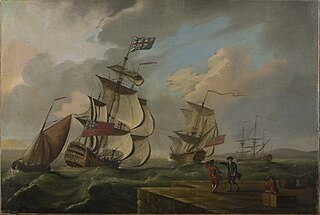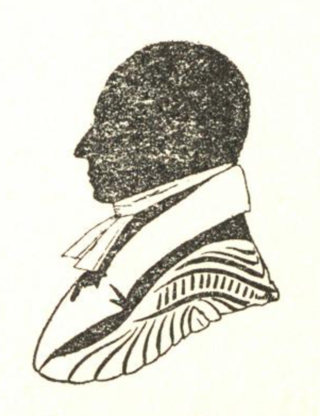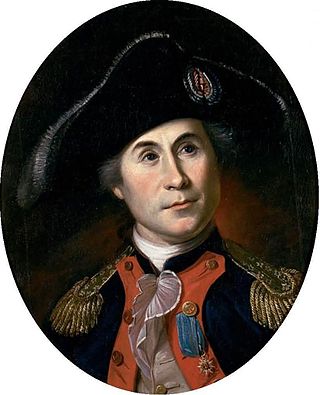
Events from the year 1783 in Canada.

John Manley (c.1733–1793) was an officer in the Continental Navy and the United States Navy. Manley was appointed commodore of "George Washington's fleet."

The Boston campaign was the opening campaign of the American Revolutionary War, taking place primarily in the Province of Massachusetts Bay. The campaign began with the Battles of Lexington and Concord on April 19, 1775, in which the local colonial militias interdicted a British government attempt to seize military stores and leaders in Concord, Massachusetts. The entire British expedition suffered significant casualties during a running battle back to Charlestown against an ever-growing number of militia.
Sir John Sherbrooke was a successful and famous Nova Scotian privateer brig during the War of 1812, the largest privateer from Atlantic Canada during the war. In addition to preying on American merchant ships, she also defended Nova Scotian waters during the war. After her conversion to a merchantman she fell prey to an American privateer in 1814. She was burnt to prevent her reuse.
The 14th Continental Regiment, also known as the Marblehead Regiment and Glover's Regiment, was raised as a Massachusetts militia regiment in 1775, and taken into the Continental Army establishment during the summer of 1775. When the Continental Army was reestablished for 1776, the regiment was redesignated the 14th Continental. Composed of seafaring men from the area around Marblehead, Massachusetts, it manned the boats during the New York and New Jersey campaign of 1776 and the crossing of the Delaware River before and after the Battle of Trenton. The men of the regiment were only enlisted for one and a half years, and the regiment was disbanded on December 31, 1776, in eastern Pennsylvania.

The 84th Regiment of Foot (Royal Highland Emigrants) was a British regiment in the American Revolutionary War that was raised to defend present day Ontario, Quebec and Atlantic Canada from the constant land and sea attacks by American Revolutionaries. The 84th Regiment was also involved in offensive action in the Thirteen Colonies; including North Carolina, South Carolina, Georgia, Virginia and what is now Maine, as well as raids upon Lake Champlain and the Mohawk Valley. The regiment consisted of 2,000 men in twenty companies. The 84th Regiment was raised from Scottish soldiers who had served in the Seven Years' War and stayed in North America. As a result, the 84th Regiment had one of the oldest and most experienced officer corps of any regiment in North America. The Scottish Highland regiments were a key element of the British Army in the American Revolution. The 84th Regiment was clothed, armed and accoutred the same as the Black Watch, with Lieutenant Colonel Allan Maclean commanding the first battalion and Major General John Small of Strathardle commanding the second. The two Battalions operated independently of each other and saw little action together.

The schooner Hannah was the first armed American naval vessel of the American Revolution, authorized by the Continental Congress and operated by the Continental Army, and is considered by some the first vessel of the United States Navy. She was a fishing schooner owned by John Glover of Marblehead, Massachusetts and was named for his daughter, Hannah Glover. The crew was drawn largely from the town of Marblehead, with much of the ships ammunition being stored in Glover's warehouse now located at Glover's Square in Marblehead before being relocated to Beverly, Massachusetts.

John Rous was a Royal Navy officer and privateer. He served during King George's War and the French and Indian War. Rous was also the senior naval officer on the Nova Scotia station during Father Le Loutre's War. Rous' daughter Mary married Richard Bulkeley and is buried in the Old Burying Ground in Halifax, Nova Scotia.

American colonial marines were various naval infantry units which served during the Revolutionary War on the Patriot side. After the conflict broke out in 1775, nine of the rebelling Thirteen Colonies established state navies to carry out naval operations. Accordingly, several marine units were raised to serve as an infantry component aboard the ships of these navies. The marines, along with the navies they served in, were intended initially as a stopgap measure to provide the Patriots with naval capabilities before the Continental Navy reached a significant level of strength. After its establishment, state navies, and the marines serving in them, participated in several operations alongside the Continental Navy and its marines.
Hector McNeill was an Scotch-Irish immigrant to the Province of Massachusetts Bay who became a merchant mariner for the Royal Navy during the North American theater of the Seven Years' War (1756–1763). He later became the third ranking officer in the Continental Navy during the American Revolutionary War.
Nathaniel Reynolds was a shoemaker, army captain and privateer during the American Revolutionary War. He was the captain of the Blackbird.

The Raid on Annapolis Royal took place on 29 August 1781 during the American Revolutionary War. The raid involved two American privateers - the Resolution and the Reprisal - attacking and pillaging Annapolis Royal, Nova Scotia in revenge of the defeat of the Penobscot Expedition. The privateers took captive the commander of the militia John Ritchie, described as the "Governor of Annapolis." One historian described it as "one of the most daring and dramatic raids upon Nova Scotia."

The Raid on Charlottetown of 17–18 November 1775, early in the American Revolutionary War, involved two American privateers of the Marblehead Regiment attacking and pillaging Charlottetown, Prince Edward Island, then known as St. John's Island. The raid motivated Nova Scotia Governor Francis Legge to declare martial law. Despite the raid's success, George Washington immediately freed senior colonial officials the privateers had brought back as prisoners to Cambridge, Massachusetts.

The Raid on Canso took place on 22 September – November 22, 1776 during the American Revolutionary War. The raid involved American Continental Navy captain John Paul Jones attacking Canso, Nova Scotia and the surrounding fishing villages.

The Raid on Saint John took place on 27 August 1775 during the American Revolutionary War. The raid involved American privateers from Machias, Massachusetts Bay attacking Saint John, Nova Scotia. The privateers intended to stop the export of supplies being sent to the loyalists in Boston. This raid was the first hostile act committed against Nova Scotia and it resulted in raising the militia across the colony.
The Raid on Yarmouth took place on 5 December 1775 during the American Revolutionary War. The raid involved American Privateers from Salem, Massachusetts attacking Yarmouth, Nova Scotia at Cape Forchu. The privateers intended to stop the export of supplies being sent from Nova Scotia to the loyalists in Boston.

The Province of Nova Scotia was heavily involved in the American Revolutionary War (1776–1783). At that time, Nova Scotia also included present-day New Brunswick until that colony was created in 1784. The Revolution had a significant impact on shaping Nova Scotia, "almost the 14th American Colony". At the beginning, there was ambivalence in Nova Scotia over whether the colony should join the Americans in the war against Britain. Largely as a result of American privateer raids on Nova Scotia villages, as the war continued, the population of Nova Scotia solidified their support for the British. Nova Scotians were also influenced to remain loyal to Britain by the presence of British military units, judicial prosecution by the Nova Scotia Governors and the efforts of Reverend Henry Alline.

The American frigate USS Hancock was captured by the British Royal Navy in a 1777 naval battle during the American Revolutionary War. The two highest ranking naval officers of the war battled each other off the coast of Nova Scotia. HMS Rainbow, under the command of British Admiral George Collier, captured USS Hancock, under the command of Captain John Manley.

Captain David Ropes was a notable American privateer from Salem, Massachusetts who fought in numerous naval battles during the American Revolution. He was taken prisoner twice during the war and then killed in the Battle off Halifax (1782).

Captain Nicholson Broughton (1724–1798) of Marblehead, Massachusetts was the first commodore of the American Navy and, as part of the Marblehead Regiment, commanded George Washington’s first naval vessel USS Hannah. Broughton set sail from Beverly, Massachusetts on 5 September 1775 in Hannah. He also led the first American expedition of the war, which went to interrupt shipping British armaments off Nova Scotia. On the expedition, Broughton participated in the Raid on Charlottetown. As a result of Broughton's expedition to Nova Scotia, the Governor of Nova Scotia Francis Legge declared martial law throughout the colony.














